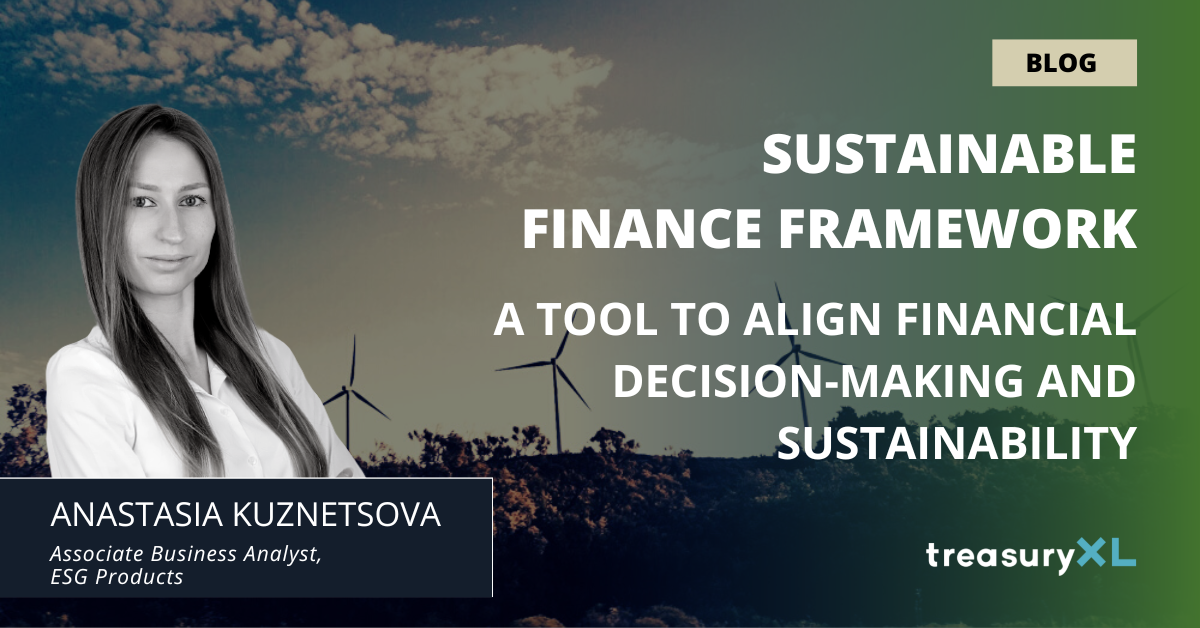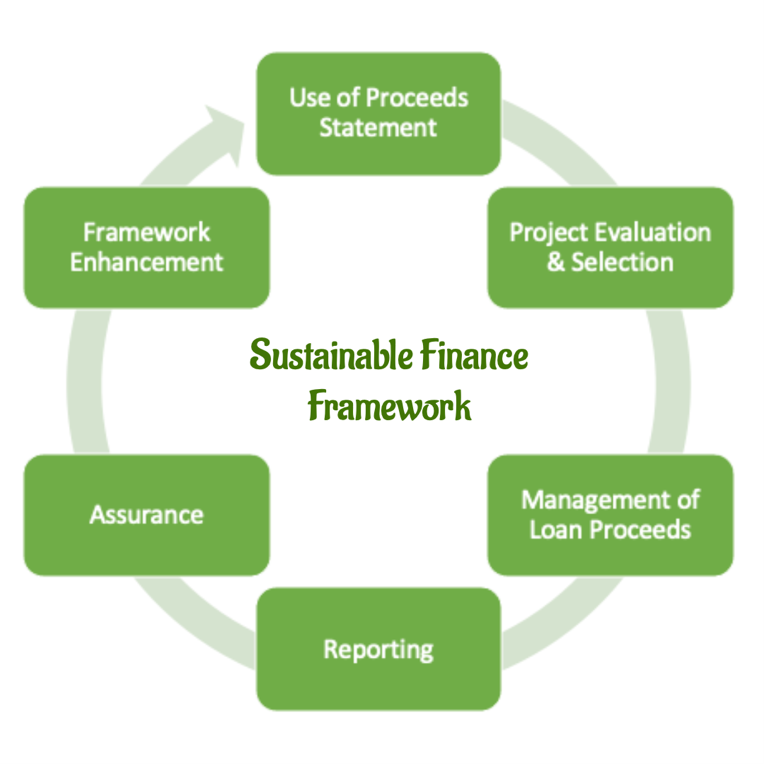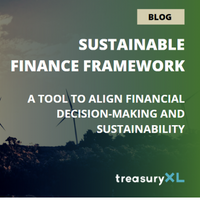Sustainable Finance Framework – A tool To Align Financial Decision-Making and Sustainability
06-02-2023 | Anastasia Kuznetsova | treasuryXL | LinkedIn |
The recent increase in ESG awareness among consumers and investors, along with regulatory pressure, has prompted companies around the world to incorporate ESG aspects into their business models in order to become sustainable.

However, a transition to more sustainable operations is not possible without new financing. Thus, Corporate Treasurers can significantly help companies to achieve their ESG goals by raising funds for the company’s sustainable initiatives. This can be done through the creation of a sustainable finance framework, which has gained popularity among companies in recent years.
Sustainable Finance Framework and its Components
A sustainable finance framework aims to align financial decision-making with the principles of sustainable development. The framework outlines how a company uses environmental, social, and governance (ESG) factors in its financing, refinancing, and investment processes. As a starting point, corporations typically establish a sustainable finance framework to arrange debt financing for a certain group of projects with positive environmental or social benefits. Many organizations set up their sustainable finance framework in accordance with international guidelines such as the Green Bond Principles (GBP) or Social Bond Principles (SBP), which support the issuance of ESG-related debt.
A well-defined sustainable finance framework will typically contain five components:
- Use of Proceeds Clause and Eligible Projects
The use of Proceeds clause defines categories of projects for which a company can use debt proceeds that were raised under its sustainable finance framework. For instance, the Framework of a property developer may cover the issuance of green and social bonds for three project categories:
- acquisition/development of low-carbon buildings
- wastewater management
- affordable housing.
Each project category will also have specific ESG criteria that will help to identify truly sustainable investment opportunities eligible for sustainable financing. For example, a project category “acquisition/development of low carbon buildings” may only allow spending debt proceeds on the acquisition of buildings with an energy efficiency rating of A. Projects that do not fall under eligible project categories, or projects that do not satisfy the established ESG criteria within each project category, will not receive sustainable financing and, thus, will not be undertaken by the company.
- Process for Project Evaluation and Selection
Another crucial component of a sustainable finance framework is project evaluation and selection. Corporate Treasurers should establish a method for determining whether new projects available for the company fit eligible project categories and, therefore, can be adopted. All selected projects included in a sustainable finance framework should be reviewed on a periodic basis and before new financing is raised. As a rule, a full list of eligible projects is examined and approved by the CFO to confirm that they meet the ESG criteria of the Framework and, thus, can receive financing.
- Management of Proceeds
After the sustainable financing is raised, Treasurers should ensure that funds are properly allocated and used in accordance with the “use of proceeds” clause. Thus, the sustainable finance framework should specify how a company will track the disbursements and allocation of debt proceeds among eligible projects.
- Funds Allocation Disclosure & Impact Reporting
The fourth component of the sustainable finance framework is the periodic disclosure of debt-related and project-related information. As long as a company has some outstanding debt raised within its sustainable finance framework, it should disclose, at least annually, the total amount of ESG debt raised, the remaining outstanding proceeds and the allocation of the proceeds across eligible projects. Such disclosures will help the company’s debtholders to understand how and to what extent their capital has been deployed by the organization.
Companies should also evaluate the environmental/social impact of funded projects via verifiable Key Performance Indicators (KPIs). For instance, a property developer can measure the environmental impact of projects under the “acquisition/development of low carbon buildings” category by energy consumption (kWh) and/or energy intensity (kWh/m2) KPIs. Impact reporting is crucial to assess whether the projects that received sustainable financing have achieved the expected positive environmental/social benefits.
- Assurance
The last attribute of the sustainable finance framework is independent external assurance. This step is needed to confirm the credibility of the established Framework as well as attest the compliance of the debt issuance process with the principles of international guidelines adopted by the company as a foundation for its sustainable finance framework.
The Enhancement of the Sustainable Finance Framework
The ultimate objective of a sustainable finance framework is to drive the financing of all corporate activities that align with the company’s sustainability goals. As such, Treasurers should gradually broaden the Framework by incorporating other sustainable finance instruments, such as convertible green bonds or sustainability-linked revolving credit facilities, to finance a diverse range of sustainable initiatives that support a company’s transition towards more sustainable operations. Over time, the Framework should be continuously expanded to include the development of new products/services and other sustainable business activities, instead of being limited to the financing of specific project categories that were initially defined in the use of proceeds clause.

Core Benefits of the Sustainable Finance Framework
The implementation of the sustainable finance framework can potentially result in the following benefits for the company.
- Improved Risk Management
By inclusion of ESG factors in the financial decision-making process, the Framework ultimately forces companies to consider environmental and social risks as well as their interdependences when evaluating investment opportunities. This enables businesses to receive a more complete picture of their risk exposures and, therefore, timely put in place adequate risk management tools that are required to keep company’s exposure to risks at an acceptable level.
The improved risk management that accounts for ESG-related risks is also likely to increase the confidence of capital providers in the company’s ability to survive in the long-term and remain profitable during challenging times. This, in turn, might improve a company’s credit rating, decrease the cost of capital, and enable businesses to obtain new financing on more favourable terms.
- Increased Access to Capital
Sustainable finance has gained significant momentum in recent years. Therefore, companies that are perceived as environmentally and socially responsible are more likely to receive investment from impact-oriented investors and financial institutions. Thus, the implementation of the sustainable finance framework can increase a company’s access to capital and provide new source of financing in the face of ESG-oriented investors.
- Enhanced Reputation & Credibility
The implementation of a sustainable finance framework also demonstrates a company’s commitment to sustainability, which can lead to a better reputation among stakeholders, and enhance the company’s credibility and trust. This may translate into a wider pool of investment options and stronger relationships with suppliers, customers, and other stakeholders.
Key Takeaways of the Sustainable Finance Framework
- The sustainable finance framework is an effective tool that can be used by Corporate Treasurers to connect a company’s ESG strategy and financial decision-making.
- The Framework helps organizations to raise financing for corporate initiatives that support a company’s sustainability goals and have a positive environmental/social impact.
- By adopting a sustainable finance framework, companies can show their commitment to sustainable development, improve risk management practices and receive greater access to capital. Given this, Corporate Treasurers should consider an opportunity for the development and implementation of a sustainable finance framework within their organizations.
Thank you for reading!




